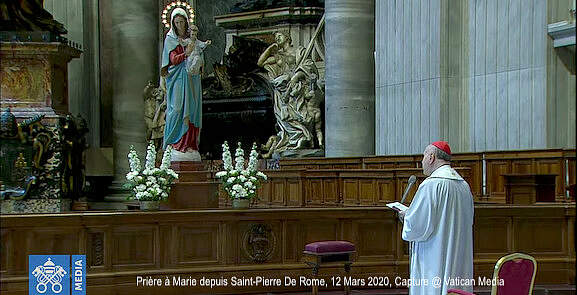
The second title may be more obscure for Catholics outside of Rome. Mother of Divine Love, or Madonna del Divino Amore, is associated with a countryside church about 12 miles from Rome’s historic center. Divino Amore traces its first miracle to the 18th century, much later than the Salus Populi Romani icon. A pilgrim was attacked by wild dogs on the way to St Peter’s and he cried out to an ancient painting of the Madonna and Child on a nearby tower. The dogs yielded, and the pilgrim credited his safety to Our Lady. As the story spread, devotion to the Mother of Divine Love grew and eventually a shrine was built in her honor.
The image became important for the whole city of Rome at the height of WWII. Afraid that the war would reach the city, the Roman people begged the priests and the pope to take the image from its shrine to the Church of St Ignatius in the middle of Rome. When the Allies liberated the city on June 4, 1944, Pope Pius XII declared the Mother of Divine Love as Rome’s savior.
Today, Catholics in Rome continue to call on the Madonna del Divino Amore when in trouble. Virtually every surface of the old shrine, the surrounding garden and even the gift shop is covered in grazie, small votive offerings from devoted pilgrims. These grazie feature photos, trinkets and little stories explaining how Our Lady of Divine Love saved loved ones from cancer, injury and other life-threatening illnesses. And every Saturday from Easter to October, a few hundred pilgrims walk through the 12 miles from Rome to the shrine through the night. These nocturnal pilgrimages, which begin at midnight and end with a 5 a.m. Mass in the shrine, often do not appear in guidebooks or “Things to Do in Rome” listicles.
It would be easy to read Pope Francis’ prayer and miss these references to Rome’s particular relationship with the Mother of God. On one hand, the pope is fulfilling his role as bishop of Rome by alluding to the two most important Marian centers in the city. On the other hand, I think he is also inviting the whole world into Rome’s intimacy with the Virgin Mary. At a time of social distancing, increased anxiety and worldwide fear, Pope Francis is not just making an appeal to Catholic devotion. He is calling us all to consider Mary not as an abstract helper but as a mother who has a proven track record of healing, protecting and watching over her people.